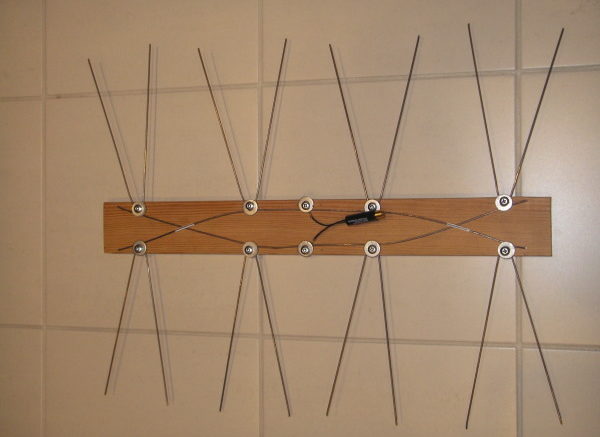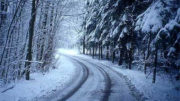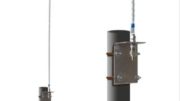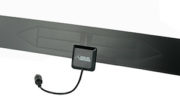Why spend a ton of money for an antenna when you can use a couple of coat hangers and a 2×4? That’s the question being posed at several sites, including ours. We put our very own RF Expert, VOS, to the task and the answers are surprising.
It turns out that, yes, with about $5 worth of parts and a little bit of time, you can build a working antenna from a coat hanger or six. An antenna is a remarkably simple piece of equipment; all it does is intercept the path of incoming radio signals in such a way that the electricity from those signals is transferred into your radio or TV. So, in fact almost anything made out of metal can be an antenna. Add a few pieces of wire and a 300 ohm matching transformer, tack it up to a piece of wood for some stability, and you’re in business.
Why even bother? If you’ve got good signal, you can strip down some copper wire, form it into the shape of a T, and you’ll get pretty good reception.
“Wait…” you’re thinking, This information is coming from a guy who wants to sell me an antenna?” Yes, it’s true. Coathanger and bare wire antennas will work. But ask yourself, will they work well?
VOS did quite a bit of research on several antennas. He tested a cheap bowtie antenna, which is a reasonable simulation of a coathanger antenna, plus a set of VHF rabbit ears, alongside our HD-BLADE antenna which is considerably more expensive. For you raw data fans…
| RFchannel | rabbit ears | bowtie | HD-BLADE | HD-BLADE (laid flat) | |
| 7 | 21 | 0 | 23 | 22 | |
| 12 | 28 | 27 | 29 | 29 | |
| 19 | 25 | 26 | 31 | 30 | |
| 27 | 29 | 30 | 27 | 30 | |
| 28 | 18 | 22 | 23 | 22 | |
| 29 | 29 | 27 | 30 | 29 | |
| 30 | 30 | 28 | 30 | 30 | |
| 33 | 30 | 29 | 29 | 29 | |
| 34 | 30 | 28 | 28 | 28 | |
| 35 | 17 | 0 | 18 | 17 | |
| 36 | 26 | 28 | 29 | 29 | |
| 38 | 27 | 26 | 27 | 27 | |
| 39 | 26 | 25 | 27 | 26 | |
| 41 | 24 | 28 | 26 | 27 | |
| 42 | 18 | 18 | 20 | 18 | |
| 43 | 29 | 26 | 23 | 26 | |
| 44 | 29 | 28 | 29 | 30 | |
| 45 | 30 | 27 | 30 | 31 | |
| 49 | 24 | 20 | 23 | 22 | |
| 50 | 27 | 24 | 25 | 26 | |
| 51 | 16 | 18 | 0 | 19 |
A bit of explanation: First, the channel numbers are the actual RF channels, not translated channels, so it does reflect rising frequencies. The signal strength numbers come from the television being used for testing and are in dB. Higher numbers are better. Where the numbers dipped below 15dB, signal strength drops to zero as 15dB is the minimum measurable signal for ATSC digital TV.
If you look at the numbers in detail, you’ll see that the difference in performance isn’t actually that great. For the most part, the HD-BLADE tops out the other two choices by a small margin, although in fairness not on every channel. Further testing showed that by adding 28″ of twin lead wire to the antenna lead you can improve performance of the bowtie antenna even more (in some frequencies.) So you might be thinking that the best thing to do is raid the closet and make yourself a $5 antenna, right?
Here’s how numbers lie.
There is an important factor which is not being shown by this test. First,all results were gained by rotating the antennas to their best possible point. if you build an antenna out of a 2×4 and coat hangers, it can become quite difficult to position it properly. On the other hand, the HD-BLADE, while not stiff enough to stand up on its own, is quite a bit smaller than a homemade 2×4 antenna and therefore easier to position for optimum reception. If you’re putting an antenna inside, positioning options may be limited.
Compared to a 2×4 with coat hangers sticking out, the HD-BLADE is a miracle of packaging. It’s as thick as a piece of paper and hides on top of a black component or on a white wall. It’s easy to mount — a piece of masking tape or even a piece of chewing gum will keep it in place. While there are some people who treasure the idea that their homes look polished and friendly. Not everyone wants a coat hanger and 2×4 sculpture, especially one that’s easily 75cm x 30cm, hanging on the wall or on a post in the middle of a room so it can be easily aimed. Sometimes we have to allow for a little bit of cosmetics to enter into our decision making.
When looked at that way, a pre-made antenna does look like a better and better deal. It may be fun to monkey around with wire hangers, but at the end of the day, you’ll get similar or better performance, a smaller and more cosmetic package, and a much easier, set-it-and-forget-it installation with the HD-BLADE. The engineers who designed it worked long and hard… so you don’t have to.
The image at top was found at a random site. It is not characteristic of the bowtie antenna used in this test.





